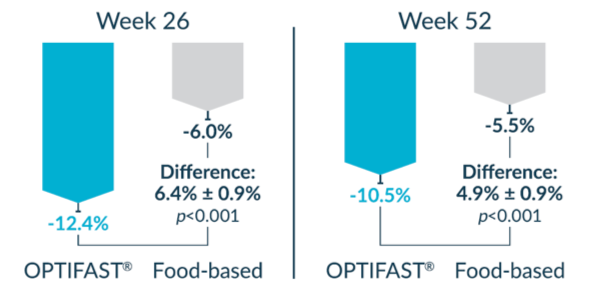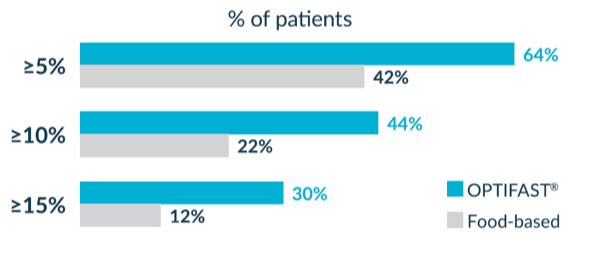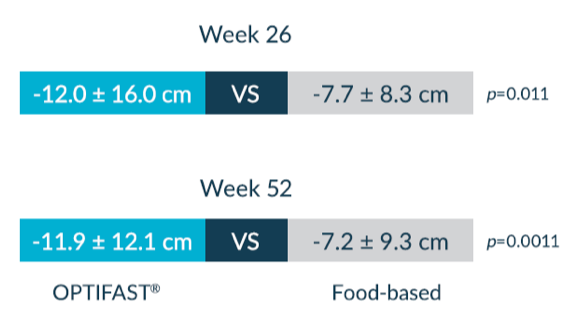Duration
52 weeks: 26-week weight loss phase, followed by a 26-week weight maintenance phase.
How?
Open-label, randomized, controlled trial
Where?
Multicenter (9 sites across the U.S.)
Participants
330 eligible for study; 273 in the mITT* study population
Method
In both groups
150-180 minutes per week of moderate to vigorous intensity exercise
Group (weekly) and individual (per schedule) behavioral counseling sessions


(n=135 mITT*)
Active Phase
Total meal replacement up to 16 weeks
800 kcal/day, based on BMI
40% carbohydrate, 40% protein, 20% fat
Gradual introduction of food up to 26 weeks
Maintenance Phase
Conventional food, encouraged 1-2 meal replacements per day.

FOOD-BASED PROGRAM
(n=135 mITT*)
Active Phase
Reduced energy (-500 to -750 kcal/day, 25% to 30% fat) diet based on *modified Diabetes Prevention Program for 26 weeks.
Maintenance Phase
Increased energy intake to achieve weight maintenance.
Results
Mean weight loss (%)
Patients lost approximately 2x as much weight using the OPTIFAST® Program

Mean change in total fat mass (kg)
OPTIFAST® Program patients achieved greatest reductions in total fat mass

Mean change in waist circumference (cm)
Patients experienced greater reductions in waist circumference using the OPTIFAST® Program

1. Ard JD, Lewis KH, Rothberg A, et al. Effectiveness of a total meal replacement program (OPTIFAST® program) on weight loss: results from the OPTIWIN study. Obesity. 2018; doi: 10.1002/oby.22303.
2. Ard JD, Schroeder MC, Kivilaid K, et al. Practical application of a comprehensive weight management program in patients with and without metabolic syndrome. J Obes Weight Loss Ther. 2014;S4:007.
3. Drawert S, Bedford K, Largent D. Change in glucose, blood pressure, and cholesterol with weight loss in medically obese patients. Obes Res. 1996;4(Suppl 1):67S.
4. Wadden TA, Foster GD, Letizia KA, Stunkard AJ. A multicenter evaluation of a proprietary weight reduction program for the treatment of marked obesity. Arch Intern Med. 1992;152(5):961-966.
5. Krishnaswami A, Ashok R, Sidney S, et al. Real-World Effectiveness of a Medically Supervised Weight Management Program in a Large Integrated Health Care Delivery System: Five-Year Outcomes. Perm J. 2018;22:17-082.
6. Hutcheon DA, et al. Short-Term Preoperative Weight Loss and Postoperative Outcomes in Bariatric Surgery. J Am Coll Surg. 2018;226:514-524. (doi:10.1016/j.jamcollsurg.2017.12.032)
7. Tarnoff M, et al. An evidence based assessment of preoperative weight loss in bariatric surgery. Obes Surg.2008;18:1059-1061.